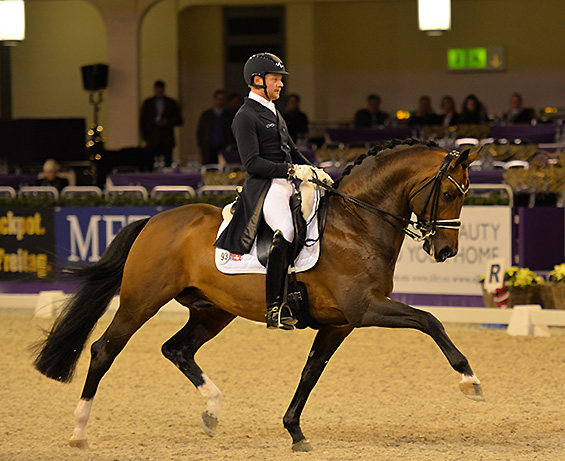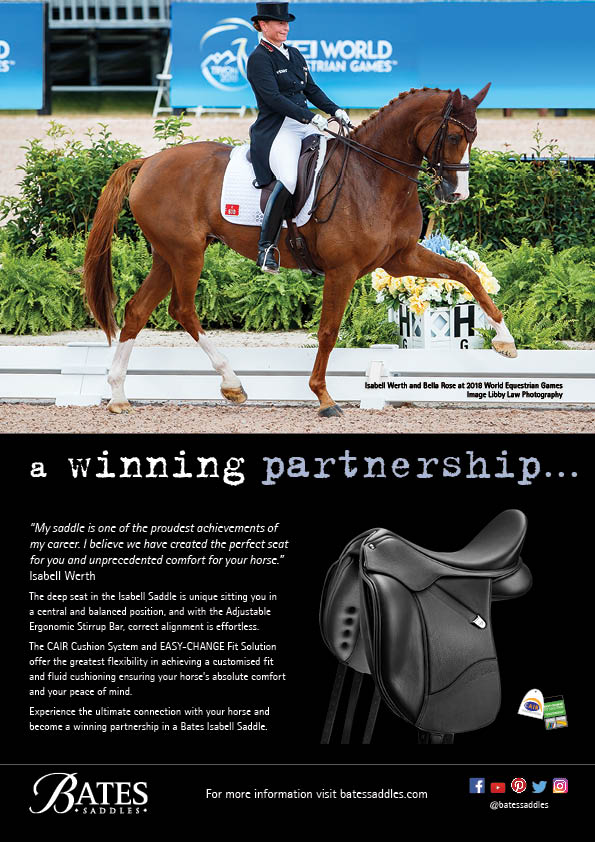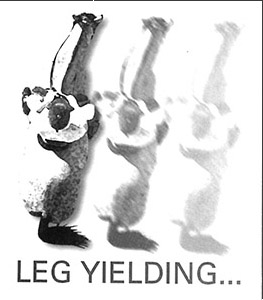
In this second part of our training special we look at the various ways you can ride the leg yield – and consider why you should use this much discussed exercise.
If you haven’t read the first part of this series, click here and go there first.
There are several possibilities of riding leg yields in the arena with different degrees of difficulties. I will list them in their increasing order of difficulty:
I. Leg yielding along the long side with two options: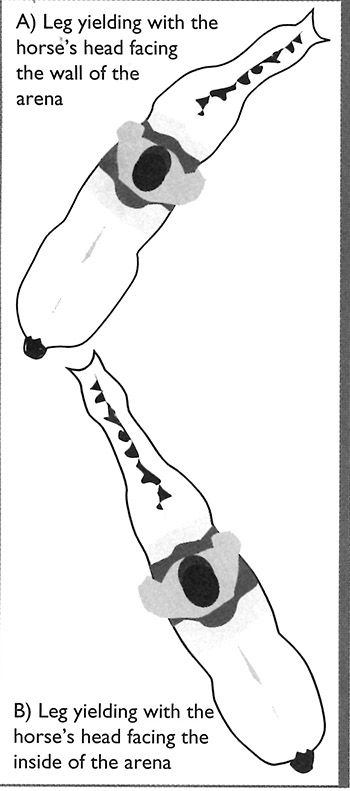
2. Leg yielding on the diagonal. If you are coming from the right rein, you have to ride only leg yielding left away from the left leg. If you are coming from the left rein the correct way to ride leg yield would be away from the right leg.
3. Leg yielding on the circle, with two options: a.- on the open side of the circle, using the closed side to ride forward to refresh the walk; b.- on the whole circle. If you are on the right rein you have to ride leg yielding right; on the left rein, leg yielding left; always flexed at the poll to the inside of the circle.
In addition to these three possibilities, you may ride leg yielding variations, such as: on the centre line either leg yielding right or leg yielding left, or on diagonal lines, counter change of rein, etc. This last, in addition to its intrinsic gymnastic value, is an important touchstone for the rider to gauge suppleness, relaxation, acceptation and obedience to the aids.
The experienced rider will choose from the above mentioned possibilities, taking into account the degree of difficulty they represent, and harmonising that with the level of training reached by the horse.
For the beginner rider, or green horse, it is easier to perform leg yielding on the track along the long side of the arena facing the wall. The limiting influence of the wall will help the rider concentrate better, applying the aids without using too strong hands which is typical of beginners. The horse also will move more confidently sideways having the helping influence of the wall.
Once the leg yield becomes established try the more demanding form with the horse facing the inside of the arena, without the guiding or limiting influence of the wall. Note however that the wall is also contributing to the hind legs keeping close to each other on the track and is a help to a better engagement of them in the direction of the horse’s centre of gravity without permitting any falling out of the outside hind leg.
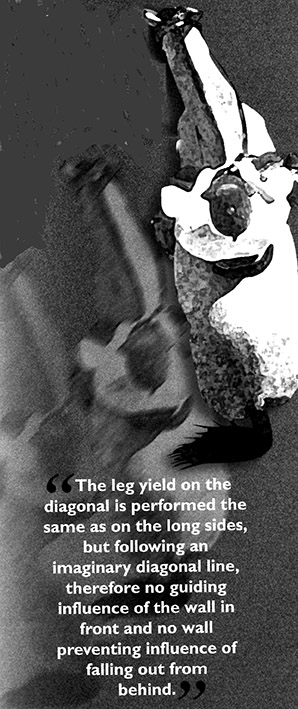
The next step to increase the demands would be first to leg yield on the diagonals of the arena and then on the circle. The leg yield on the diagonal is performed the same as on the long sides, but following an imaginary diagonal line, therefore no guiding influence of the wall in front and no wall preventing influence of falling out from behind.
Leg yielding on the circle is executed similarly to leg yielding on the long sides of the arena with the horse facing into, and being flexed to the inside of the circle, with a slight bend to the horse’s body following the curve of the circle being ridden. The execution becomes very close to shoulder-in. To leg yield on a circle increases the degree of difficulty because the hind leg will engage more. They have to step on the circle line and the rider must apply the forward-sideways driving aids inside as well as preventing the horse from evading to the inside of the circle (with steps like travers), while the forward guarding aids on the outside will prevent the horse from falling outside of the circle.
How do you apply the aids?
Imagine you are on the right rein at medium walk and want to ride leg yield on the long side with the head facing to the wall of the arena. First make the horse attentive that a new exercise is about to begin through a half parade outside (on the left side). You then have to flex the horse’s head at the poll to the left, with the left rein. In this moment the left side becomes the inside, despite that this side is to the outside of the arena: ‘Inside’ is always the side to which the horse is bent or positioned, regardless of the orientation of the horse to the outside or inside of the arena. Apply a half parade on the left side pushing at the same time, with your left leg just behind the girth to get the left hind leg of the horse forward, and also laterally into the off rein, which is held firm, but with elasticity in your fingers (with the inside rein you have to give only as much as the position inside is requiring without interrupting the more or less firm contact. If you miss this and allow the horse to bend more than is necessary, you run the risk of the evasion of falling over the outside shoulder.)
The horse will cross with the inside hind (in this case the left) over and in front of the outside hind leg (right), before putting the left foot on the ground. In this moment you should give with the reins and cease to push with your leg (the passive part of the half parade). Then, when the right hind begins to lift off the ground, you have to prevent and guard it with your outside leg and limit the tendency of this hind leg to fall out (more laterally) encouraging this hind leg rather to step forward.
The next moment when the left hind leg is ready to come off the ground again, you have to apply a half parade to the left side again, while pushing the left hind to cross over, and in front of the outside one and so on. This procedure you have to repeat each step again and again, to be able to keep the flow of the movement and to continue the leg yielding.
So much for the action of the legs as a part of a half parades. Now let’s look at the rider’s seat and rein aids. The rider sits on both seat bones with slightly more weight on the inside. The inside rein maintains softness in the poll and the slight head flexion to the inside. The outside rein limits this flexion and keeps the neck straight on the shoulder and prevents, together with the guarding outside leg, a falling out over that shoulder. The outside rein is also the guiding rein, during the leg yielding. In this way the horse will move forward and sideways at medium walk rhythm.
Now please note! The horse will move in fact to the right, but away from the rider’s left leg. This is called ‘leg yield left’.
To sum up: the horse moves (in this case) to the right, but away from the rider’s left leg, therefore it is a leg yield left and not leg yield to the right as some would assume. It always refers to the leg of the rider that the horse is moving away from (yielding).
It is important to end the leg yield on the long side at the quarter marker and straighten the horse, who has then to be ridden forward at medium walk.
a.- If you were riding with the head facing the inside of the arena, the straightening has to be done through placing the forehand in front of the hindquarters without changing the position at the poll (the forehand has to be brought in front of the hindquarters, by pivoting the shoulders around the hindquarters).
b.-If you have ridden leg yield, with the horse’s head facing the wall, you have to change his position and place the hindquarters up to the forehand by just riding forward (at medium walk), so that the hindquarters will follow the forehand.
Counter change of hand at the leg yield.
This is the highest degree of difficulty of all the leg yield options, as well as the touchstone or proof that this gymnastic exercise has achieved its aim: relaxation, suppleness, acceptance of the bit and the unconditioned obedience of the horse to the rider’s aids.
The precondition to be able to perform the change of hand well is to be 100% in command of your horse at leg yield on long sides and diagonal lines on both reins.
In the beginning the leg yield has to be executed exactly the same way as on any diagonal line: after riding at medium walk through the second corner of the short side and coming on the long side, just before the quarter marker you have to apply a half parade outside to ask the horse for attentiveness. Then place the forehand on the diagonal and give the horse the new position (bent at the poll), by putting a little bit more weight on the new inside seat bone and with the new inside leg placed just behind the girth, push the inside hind forward and laterally on the diagonal line. The action of this leg has to be supported, as in any half parade, by the inside rein and by the outside limiting leg and rein aids which give and maintain the position of the horse (flexed at the poll). The outside leg of the rider is in its guarding position behind the girth catching with in each step the outside hind of the horse and driving it forward, preventing at the same time with the limiting support of the outside rein, a falling out of this hind leg or falling out of the horse over its outside shoulder.
The horse moves straight through its body, slightly positioned (at the poll), more forward than sideways on two tracks which are one step apart from each other in the direction of the centre of the arena (X) and nearly parallel to the walls. The forehand has to be just ahead of the hindquarters which must never take the lead during the movement. (If the hindquarters take the lead, the gymnastic effect of the leg yielding will be lost, because the hind leg will not step under the body of the horse to carry the weight. The same thing happens at half pass if the hindquarters will come ahead of the forehand).
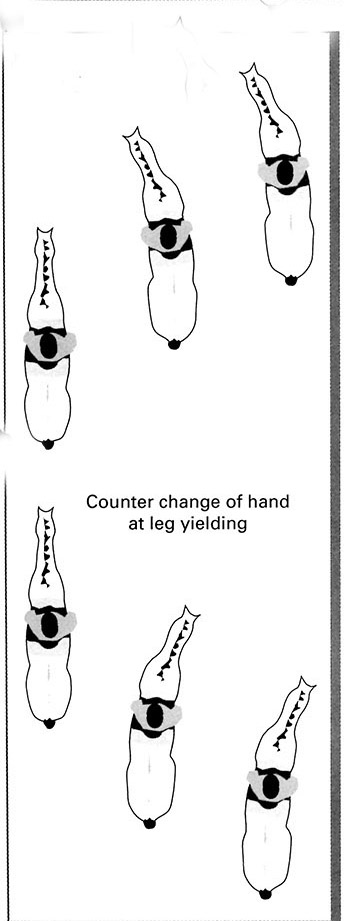
Coming to the middle line of the long sides (B-E line; it varies from about 5 metres to the inside of the arena till at most to X, depending on the degree of preparation achieved by the horse), the horse has to be straightened for one horse length (three steps while riding forward at medium walk) before its position is changed to begin the new leg yield which is executed the same way as before on the new diagonal line to the quarter marker at the end of the long side where the counter change of hand finishes.
Because of the change of the directions, the demands are increased for the riders with respect to the feel in applying the inside aids and the clarity and effectiveness of the outside ones, as well as the obedience of the horse to these influences on both reins. A horse is really obedient to the leg when the half parades are coming ‘through’ i.e. the horse responds willingly to the leg pressure supported by the rein aids of the same side (giving and taking aids in coordination with the leg aids as components of the active or passive part of the half parade). As a result of the improved response of the horse to the rider’s aids, it will engage the hind leg better i.e. bend and step with them more under its body towards its centre of gravity taking more weight and therefore getting prepared for collection.
At this moment leg yielding has accomplished its duty. The horse is ready; the path to the lateral movements (shoulder fore, shoulder in, travers, renvers, half pass) is clear.
Isabell Werth shows us half pass with Bella Rose
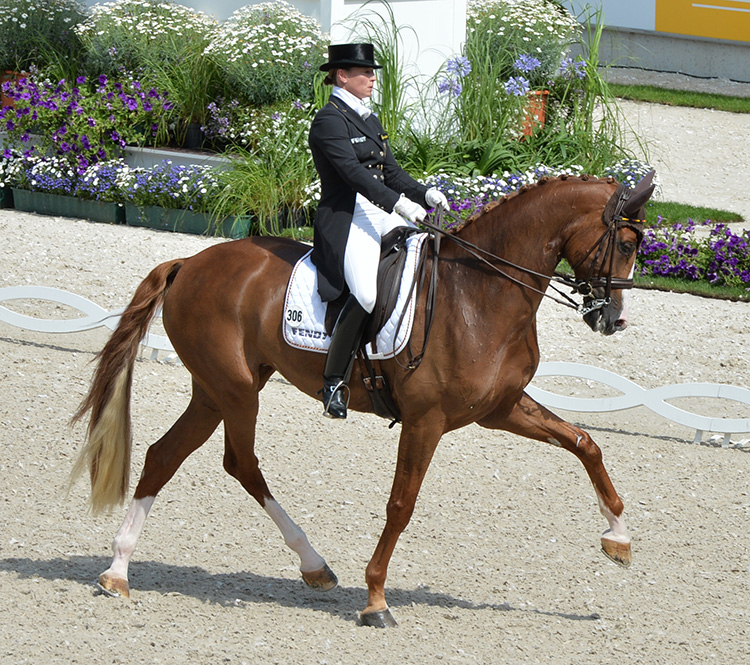
next step follows
Turn on the forehand
Turning on the forehand is a movement related to leg yielding and therefore also controversial: the rider has to apply aids like leg yield, while the horse’s hind legs are crossing (one in front and over the other) as in making a circle, around its inside fore which stays at the centre and acts as a pivot. The turn on the forehand has as its aims to teach the horse to accept the outside rein, and therefore the bit, and to respond to the sideways driving leg of the rider. Thus, it is a preparation for the leg yield and all the other lateral movements in addition to improving obedience to the rider’s leg.
“Only if you control the hind legs you control the entire horse!”
It is an exercise which helps the relaxation and suppling of the horse, especially the relaxation of its jaw, and also functioning as preparation for teaching the horse the rein back. From the gymnastic point of view it has little value because it puts the horse on the forehand.
On this point all the trainers agree. This is an exercise that should be used only with young horses at the beginning of their preparation, and once these aims are achieved, not used anymore.
For the young or novice rider it is a very good exercise to improve of their riding ‘feel’, because of the application of alternate aids eliciting their different influences.
So much for the theory: now let’s go to its application:
Turn on the forehand can be done out of the walk (for example as a continuation of leg yielding when changing directions) or started from a halt.
In an indoor arena this turn should be carried out on the second track (about 80-100 cm inside the first track), otherwise there is not enough room for the horse’s neck and head to execute this turn.
It begins with a half parade outside, to make sure the horse is attentive, then the horse has to be flexed at the poll with the inside rein, while the outside rein is giving accordingly. There are two ways to perform this turn:
a.- with the horse flexed to the side where the hind leg is pushed by the rider’s leg, just behind the girth, and supported by the rein in the same side, to cross over and inside the outside hind leg, this being the most used form, or
b.- With the horse flexed to the opposite side of the hind leg made to step over. In this case, the outside hind crosses over the inside one, this way being more demanding and difficult to execute for both: horse and rider.
This Renvers-like form of turn on the forehand is nowadays seldom used.
In both cases, the horse’s non crossing leg has to be caught and limited by the opposing driving leg which is kept on the horse’s body about a hand width behind the girth to ensure that the horse stays still after each step, between the rider’s legs. The rein on this side prevents a falling out, and keeps the neck straight at the shoulder. Then the next step must be done in the same way until the horse performs step by step a turn of 180 degrees.
The reins prevent the horse from moving forward. For the horse to step back is not as big a mistake as stepping forward during the turn.
The turn is not correct if the horse is turning and moving sideways without the first stepping hind leg crossing over and in front of the other one. If this occurs, the influence of the catching, limiting rider’s leg must increase to pin down the horse’s hind leg on this side, so that the opposite hind leg can be pushed to cross over and in front by the rider’s sideways driving leg. Finally I would like to mention ‘the volte in swivel’ (Volte im Schwenken), another movement related to leg yield and turn on the forehand, which unfortunately is very seldom used.
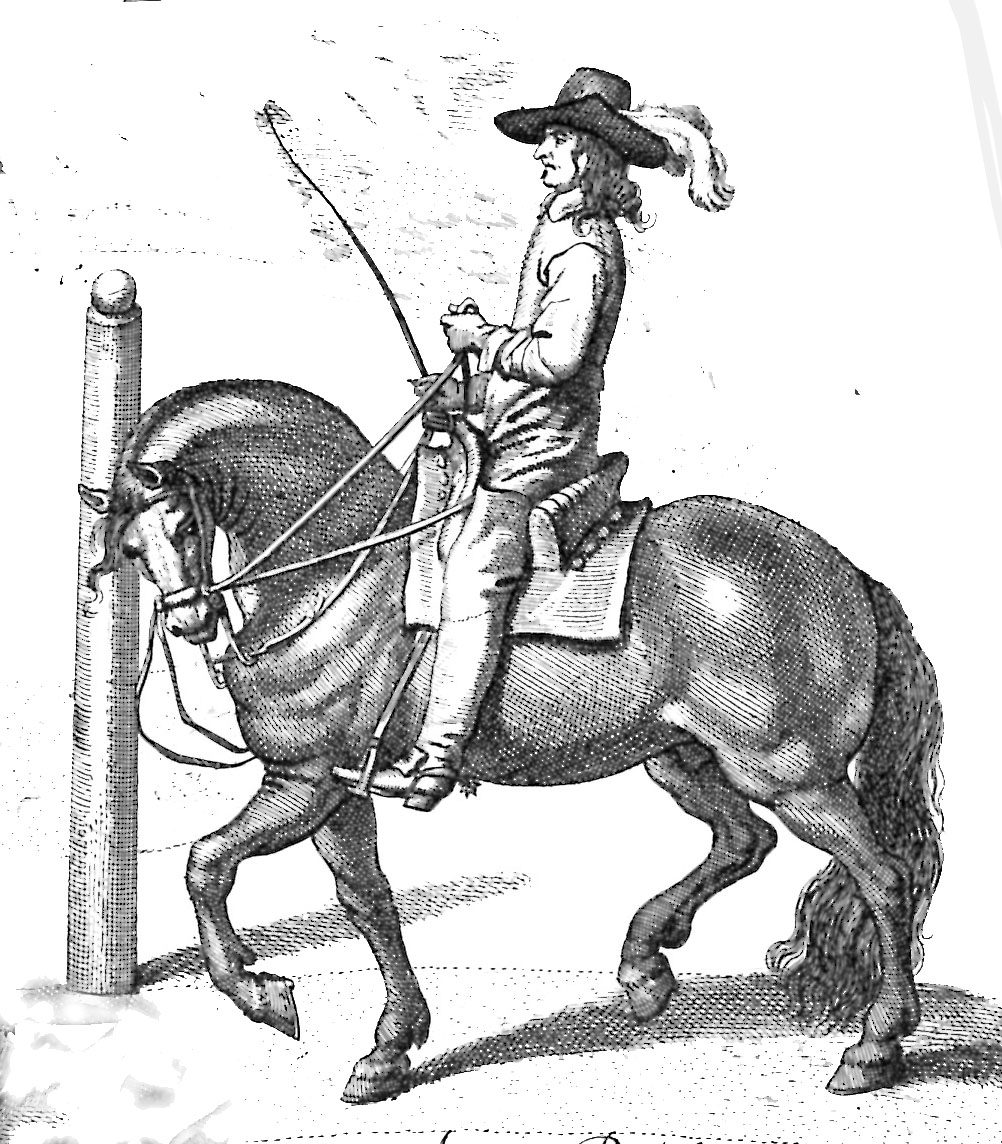
This movement has its origin with the Duke of Newcastle, the 17th century trainer and writer, who called his movement ‘Head in the Volte’. The young horse is working on a circle around a pillar, which is in reality a turn on the forehand in the movement. That is in fact the volte into swivel, a turn on the forehand in the movement executed on a volte (small circle of 6- 8 metres).
Waldemar Seunig, the most prestigious theoretician of the last century (he was also a gifted rider and riding teacher) expresses his regret about ‘the time saving advantages of this movement, from which today is made too little use.’ He continues “through this exercise, after the loosening to the inside aids the horse accepts with ease the outside ones and in this way, in an unconstrained manner will be ready for the collected movement of the shoulder-in, the point line of departure for the lateral paces.”
Interested in dressage? There’s lots more great articles from great trainers here: http://www.horsemagazine.com/thm/article/dressage/
Foundation, available in Australia from International Horse Breeders – Go to www.IHB.com.au
